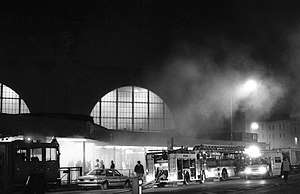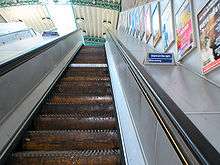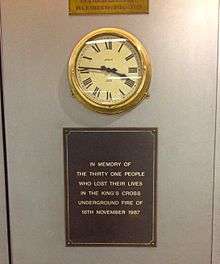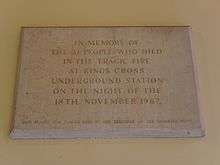King's Cross fire
 A police car, three fire engines and an ambulance outside King's Cross | |
| Date | 18 November 1987 |
|---|---|
| Time | 19:30 |
| Location | King's Cross underground station |
| Country | United Kingdom |
| Type of incident | Station fire |
| Cause | Lit match being dropped into an escalator and trench effect |
| Statistics | |
| Trains | None |
| Deaths | 31 |
| Injuries | 100 |
| List of UK rail accidents by year | |
On 18 November 1987, at approximately 19:30, a fire broke out at King's Cross St. Pancras tube station, a major interchange on the London Underground. As well as the mainline railway stations above ground and subsurface platforms for the Metropolitan lines,[lower-alpha 1] there were platforms deeper underground for the Northern, Piccadilly, and Victoria lines. The fire started under a wooden escalator serving the Piccadilly line and, at 19:45, erupted in a flashover into the underground ticket hall, killing 31 people and injuring 100.
A public inquiry was conducted from February to June 1988. The investigators reproduced the fire twice, once to determine whether grease under the escalator was ignitable, and the other to determine whether a computer simulation of the fire—which would have determined the cause of the flashover—was accurate. The inquiry determined that the fire had started due to a lit match being dropped onto the escalator. The fire seemed minor until it suddenly increased in intensity, and shot a violent, prolonged tongue of fire, and billowing smoke, up into the ticket hall. This sudden transition in intensity, and the spout of fire, was due to the previously unknown trench effect, discovered by the computer simulation of the fire, and confirmed in two scale model tests.
London Underground were strongly criticised for their attitude toward fires. Staff were complacent because there had never been a fatal fire on the Underground, and had been given little or no training to deal with fires or evacuation.
A report was published on the inquiry, leading to resignations of senior management in both London Underground and London Regional Transport and to the introduction of new fire safety regulations. Wooden escalators were gradually replaced with metal escalators on the London Underground.
Fire
At King's Cross (like at the mainline railway station above ground and subsurface platforms for the Metropolitan line), there are platforms deeper underground for the Northern, Piccadilly, and Victoria lines. An escalator shaft led down to the Victoria line, and another led down to the Piccadilly line, and from that the Northern line. Stairs connected the Piccadilly and Victoria line platforms[1] and from these there was a subway to King's Cross Thameslink railway station platforms used by British Rail Midland City (later Thameslink) trains to Moorgate and an entrance in Pentonville Road.[2]
At about 19:30 several passengers reported seeing a fire on a Piccadilly line escalator. Staff and police went to investigate and on confirming the fire one of the policemen went to the surface to radio for the fire brigade.[3] Four fire appliances and a turntable ladder were sent at 19:36 by the London Fire Brigade.[4] The fire was beneath the escalator, and it was impossible to reach it to use a fire extinguisher. There was water fog equipment but staff had not been trained in its use.[5] The decision to evacuate the station was made at 19:39, using the Victoria line escalators.[6] A few minutes later the fire brigade arrived and several firemen went down to the escalator to assess the fire. They saw a fire about the size of a large cardboard box and planned to fight it with a water jet using men with breathing apparatus.[7]
At 19:42 the entire escalator was aflame, producing superheated gas that rose to the top of the shaft enclosing the escalator, where it was trapped against the tunnel ceiling, which was covered with about twenty layers of old paint, from repainting without removing the old paint. As the superheated gases pooled along the ceiling of the escalator shaft, the layers of paint began absorbing the heat. A few years before the fire, the Underground's director of operations had suggested that the accumulated paint might pose a fire hazard. However, painting protocols were not in his purview and his suggestion was widely ignored by his colleagues.[8]
At 19:45 there was a flashover and a jet of flames came from the escalator shaft, filling the ticket hall with intense heat and thick black smoke,[9] killing or seriously injuring most of the people in the ticket hall.[10] This trapped below ground several hundred people, who escaped on Victoria line trains.[11] A policeman with an injured man tried to leave via the Midland City platforms, but found the way blocked by locked gates until these were unlocked by a cleaner.[12] Staff and a policewoman trapped on a Metropolitan line platform were rescued by a train.[11]
Thirty fire crews—over 150 firefighters—were deployed.[13] Fourteen London Ambulance Service ambulances ferried the injured to local hospitals, including University College Hospital.[14] The fire was declared out at 01:46 the following morning.[15]
Thirty-one people died[16] and 100 people were taken to hospital, 19 with serious injuries.[17] Fire Brigade station officer Colin Townsley was in charge of the first pump fire engine to arrive at the scene and was down in the ticket hall at the time of the flashover. He did not survive; his body was found beside that of a badly burnt passenger at the base of the exit steps to Pancras Road. It is believed that Townsley spotted the passenger in difficulty and stopped to help her.[18]
An initially unidentified man, commonly known as "Michael" or "Body 115" after its mortuary tag, was identified on 22 January 2004, when forensic evidence confirmed he was 73-year-old Alexander Fallon of Falkirk, Scotland.[19] He was the subject of a 1990 Nick Lowe song, "Who Was That Man?".[20]
Aftermath
The ticket hall and platforms for the Metropolitan line were undamaged and reopened next morning; the Victoria line, its escalators only slightly damaged, resumed normal operation on the following Tuesday. The ticket hall for the three tube lines was reopened in stages over four weeks.[17] The three escalators for the Piccadilly line had to be completely replaced, the new ones being commissioned on 27 February 1989, more than 16 months after the fire. Until then, the Piccadilly line could only be reached via the Victoria line or Midland City platforms, and at peak hours in one direction only.[21]
Access to the Northern line platforms was indirect, its escalators connecting with the Piccadilly line. As the traffic from all three tube lines would have overcrowded the Victoria line escalators, Northern line trains skipped Kings Cross until repairs were complete. The nearly life-expired Northern line escalators were replaced as well and the Northern line station reopened, completing the return to normal operation, on 5 March 1989.[22]
Investigation and report
A public inquiry into the incident was initiated by Prime Minister Margaret Thatcher.[23] It was conducted by Desmond Fennell OBE QC, assisted by a panel of four expert advisers. The inquiry opened at Central Hall, Westminster on 1 February 1988 and closed on 24 June, after hearing 91 days of evidence.[24]

Smoking on Underground trains was banned in July 1984, over 3 years before the fire. Following a fire at Oxford Circus station in November 1984, the ban was extended to all underground stations in February 1985. However, smokers often ignored this and lit cigarettes on the escalators on their way out.[25] The inquiry found that the fire was most probably caused by a traveller discarding a burning match that fell down the side of the moving staircase on to the running track of the escalator.[26] The police decided that the fire had not been started deliberately, as there was no evidence that an accelerant had been used and access to the site of the fire was difficult. Investigators found charred wood in eight places on a section of skirting on an escalator and matches in the running track,[27] showing that similar fires had started before but had burnt themselves out without spreading.[28] The investigators found a build-up of grease under the tracks, which was believed to be difficult to ignite and slow to burn once it started, but it was noted that the grease was heavily impregnated with fibrous materials. A test was conducted where lit matches were dropped on the escalator to see if ignition would occur. Matches dropped ignited the contaminated grease and the fire began spreading, being allowed to burn for nine minutes before being extinguished.[29]
This test matched the initial eyewitness reports up to that point, but four expert witnesses could not agree as to how the small fire flashed over, with some concern that the paint used on the ceiling had contributed to the fire.[30] A model of King's Cross station was built at the Atomic Energy Research Establishment, and using computer simulation software; this showed the flames lying down along the floor of the escalator rather than burning vertically before producing a jet of flame into the ticket hall. The end result matched the eyewitness accounts of the tube fire, but the simulation's depiction of the fire burning parallel to the 30° slope of the escalator was thought by some to be unlikely and it was suspected that the programming might be faulty.[31] Experiments were conducted with a third scale replica of the escalator built at the UK's Health and Safety Executive site at Buxton. After seven and a half minutes of normal burning, the flames lay down as in the computer simulation.[32] The metal sides of the escalator served to contain the flames and direct the temperature ahead of the fire.[33] When the treads of the escalator flashed over, the size of the fire increased dramatically and a sustained jet of flame was discharged from the escalator tunnel into the model ticket hall.[10] The 30° angle of the escalators was discovered to be crucial to the incident, and the large number of casualties in the fire was an indirect consequence of a fluid flow phenomenon that was later named the trench effect, a phenomenon completely unknown before the fire. The conclusion was that this newly discovered trench effect had caused the fire to flashover at 19:45.[34]
London Underground were strongly criticised in the report for their attitude to fires underground, underestimating the hazard because no one had died in a fire on the Underground before.[35] Staff were expected to send for the Fire Brigade only if the fire was out of control, dealing with it themselves if possible.[36] Fires were called smouldering and staff had little or no training to deal with fires or evacuation.[35]
Legacy


The publication of the report led to resignations of senior management of both London Underground and London Regional Transport. Wooden panelling was to be removed from escalators, heat detectors and sprinklers were to be fitted beneath escalators, and the radio communication system and station staff emergency training were to be improved.[37][38]
The Fire Precautions (Sub-surface Railway Stations) Regulations 1989 were introduced. Smoking was banned in all London Underground stations, including on the escalators, on 23 November, five days after the fire. Wooden escalators were gradually replaced, some remaining into the early 2000s (Wanstead replacing theirs in 2003 and Marylebone in 2004[39]) and as of 2014 the entire London Underground was operating on metal escalators, after the last wooden escalator at Greenford Underground station was decommissioned on 10 March 2014.[40]
London Underground was also recommended by the Fennell Report to investigate "passenger flow and congestion in stations and take remedial action".[41] Consequently, Parliamentary bills were tabled to permit London Underground to improve and expand the busiest and most congested stations, such as London Bridge, Tottenham Court Road, Holborn and King's Cross St. Pancras.[42][43]
Since then, major tube stations have been upgraded and expanded to increase capacity and improve safety. London Bridge was upgraded in conjunction with the Jubilee Line Extension project, which opened in 1999,[44] King's Cross St. Pancras was substantially upgraded and expanded as a component of the High Speed 1 project in the late 2000s,[43][45] and Tottenham Court Road was expanded as part of the Crossrail project in the mid 2010s.[46]
The fire also led to improvement in firefighters' equipment: yellow plastic leggings that melted in the heat and rubber gloves that limited movement were replaced with more effective clothing.[47]
Six firemen received Certificates of Commendation for their actions at the fire, including Station Officer Townsley who was given the award posthumously.[48] Station Officer Townsley was also posthumously awarded the George Medal.[49]
Soon after the fire a commemoration service was held at St Pancras Church.[50] Further commemoration services were held on 18 November 2002, the fifteenth anniversary of the blaze, on the twentieth anniversary in 2007 at the station itself,[50] on the twenty-fifth anniversary in 2012 at the Church of the Blessed Sacrament near the station[51] and on the thirtieth anniversary in 2017 at the station, with a wreath laying.[52]
Memorial plaques commemorating the disaster were installed at St Pancras Church, unveiled by the Princess of Wales, and at King's Cross station.[50]
In popular culture
Shortly after the fire, it was incorrectly assumed that the song "King's Cross", recorded by synthpop duo Pet Shop Boys as part of their 1987 album Actually, was written in reference to the fire.[53] In fact, the album was released two months before the fire. Duo frontman Neil Tennant clarified that the song had been written as "a hymn to the people getting left out of Thatcherism".[53] Opposition MPs in the House of Commons used the event to accuse the government of sacrificing safety in cutting the transport budget.[54]
Notes and references
- Notes
- ↑ Circle line trains also call at these platforms.
- References
- ↑ Fennell 1988, figure 6.
- ↑ Fennell 1988, figure 5.
- ↑ Fennell 1988, p. 49.
- ↑ Fennell 1988, p. 50.
- ↑ Fennell 1988, pp. 51, 62.
- ↑ Fennell 1988, p. 51.
- ↑ Fennell 1988, p. 52.
- ↑ Duhigg, Charles (2012). The Power of Habit: Why We Do What We Do in Life and Business. p. 171. ISBN 081298160X.
- ↑ Fennell 1988, p. 53.
- 1 2 Fennell 1988, p. 100.
- 1 2 Fennell 1988, p. 54.
- ↑ Fennell 1988, pp. 54, 56.
- ↑ Fennell 1988, p. 82.
- ↑ Fennell 1988, p. 91.
- ↑ Fennell 1988, p. 57.
- ↑ Fennell 1988, p. 17.
- 1 2 Croome & Jackson 1993, p. 459.
- ↑ Fennell 1988, pp. 78–79.
- ↑ Duffy, Jonathan (22 January 2004). "Solved after 16 years – the mystery of victim 115". BBC News. Retrieved 28 October 2012.
- ↑ "NICK LOWE lyrics – Who Was That Man?". Retrieved 5 November 2014.
- ↑ Croome & Jackson 1993, pp. 459, 462.
- ↑ Croome & Jackson 1993, pp. 459–462.
- ↑ McNulty, Deane; Rielly, Philip (March 1992). "A Report for Dr A. Buchanan Dept. of Civil Engineering Canterbury University" (PDF). University of Canterbury: 3. Retrieved 30 April 2017.
- ↑ Fennell 1988, pp. 21–23.
- ↑ Fennell 1988, p. 94.
- ↑ Fennell 1988, p. 111.
- ↑ Fennell 1988, pp. 221–224.
- ↑ Fennell 1988, p. 114.
- ↑ Fennell 1988, p. 104.
- ↑ Fennell 1988, pp. 105–106.
- ↑ Fennell 1988, p. 107.
- ↑ Fennell 1988, p. 110.
- ↑ Fennell 1988, p. 113.
- ↑ Fennell 1988, pp. 113–114.
- 1 2 Fennell 1988, pp. 17–18.
- ↑ Fennell 1988, p. 61.
- ↑ Paul Channon (12 April 1989). "King's Cross Fire (Fennell Report)". Parliamentary Debates (Hansard). House of Commons. col. 915–917.
- ↑ "Sir Desmond Fennell". The Daily Telegraph. 5 July 2011. Retrieved 8 June 2018.
- ↑ An End To Treading the Boards, Metronet Matters, Issue 3: Metronet, 2004, p. 17
|access-date=requires|url=(help) - ↑ Mann, Sebastian (11 March 2014). "Tube's only wooden escalator to carry last passengers". London 24. Archived from the original on 29 October 2014. Retrieved 16 August 2014.
- ↑ Fennell 1988, pp. 169.
- ↑ "London Underground (Safety Measures) Act 1991". www.legislation.gov.uk. Retrieved 19 September 2017.
- 1 2 "London Underground (King's Cross) Act 1993". www.legislation.gov.uk. Retrieved 19 September 2017.
- ↑ Eng., Mitchell, Bob, C. (2003). Jubilee Line extension : from concept to completion. London: Thomas Telford. ISBN 0727730282. OCLC 51945284.
- ↑ "King's Cross St. Pancras Tube station doubles in size as state-of-the-art ticket hall opens". tfl.gov.uk. Transport for London. 27 November 2009. Retrieved 19 September 2017.
- ↑ Murray, Dick (10 February 2017). "Tottenham Court Road station's £500 million revamp completed as entrances open". London Evening Standard. Retrieved 19 September 2017.
- ↑ Evans, Alice; Thompson, Clifford (18 November 2017). "King's Cross fire: 'I was screaming in pain'". BBC News. Retrieved 8 June 2018.
- ↑ "RMT calls for staffing cuts to be scrapped on 25th anniversary of Kings Cross fire". London Evening Standard. 18 November 2012. Retrieved 8 June 2018.
- ↑ "No. 51745". The London Gazette (Supplement). 24 May 1989. p. 6217.
- 1 2 3 "Ceremony marks King's Cross fire". BBC News. 17 November 2007. Retrieved 20 April 2013.
- ↑ "King's Cross fire 25th anniversary marked". BBC News. 19 November 2012. Retrieved 19 November 2012.
- ↑ "King's Cross fire: Victims remembered at wreath-laying service". BBC News. 18 November 2017.
- 1 2 Studer, Wayne. "King's Cross". Retrieved 29 April 2017.
- ↑ "London Mourns Victims Of Subway Fire". The Dispatch. London. Associated Press. 20 November 1987. p. 18.
- Bibliography
- Croome, Desmond F.; Jackson, Alan Arthur (1993). Rails Through the Clay: A History of London's Tube Railways. Capital Transport. ISBN 978-1-85414-151-4.
- Fennell, Desmond (1988). Investigation into the King's Cross Underground Fire. Department of Transport. ISBN 0-10-104992-7. Scan available online at railwaysarchive.co.uk. Retrieved 27 October 2012.
Further reading
- Appleton, B. (1992). Report of an inquiry into health and safety aspects of stoppages caused by fire and bomb alerts on London Underground, British Rail and other mass transit systems. HSE Books. ISBN 0-11-886394-0.
- Chambers, P. (2006). Body 115: The Story of the Last Victim of the King's Cross Fire. John Wiley & Sons. ISBN 0-470-01808-9.
- Moodie, K. (1992). "The King's Cross Fire: Damage Assessment and Overview of the Technical Investigation". Fire Safety Journal, vol 18.
- Simcox, S.; Wilkes, N.S.; Jones, I.P. (1992). "Computer Simulation of the Flows of Hot Gases from the Fire at King's Cross Underground Station". Fire Safety Journal, vol 18.
- Vaughan, Adrian (2000). Tracks to Disaster. Ian Allan. ISBN 0-7110-2731-5.
- Institution of Mechanical Engineers Environmental Engineering Group (1 June 1989). The King's Cross underground fire: fire dynamics and the organization of safety. Mechanical Engineering Publications. ISBN 978-0-85298-705-6.
External links
- "Fire tactics: King's Cross fire". Archived from the original on 10 December 2013.
- BBC News 'On This Day' report
- ITN News at Ten coverage of the incident
- Fire Brigade operations – London Fire Journal
- London Underground – Fire Dynamics
- The trench effect and eruptive wildfires: lessons from the King’s Cross Underground disaster. by Jason J. Sharples, A. Malcolm Gill, & John W. Dold.
- UK legislation
- Statutory Instrument 1989 No. 1401 Fire Precautions (Sub-surface Railway Stations) Regulations 1989